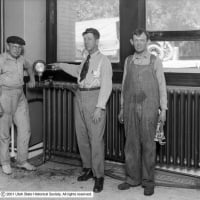Welcome! Here are the website rules, as well as some tips for using this forum.
Need to contact us? Visit https://heatinghelp.com/contact-us/.
Click here to Find a Contractor in your area.
If our community has helped you, please consider making a contribution to support this website. Thanks!
what type of radiator/boiler system is this?
Options

Timco
Member Posts: 3,040
You have a hot water system. The vents on the rads give it away. Rads are just different types. How old is the boiler? Pictures? The rads will perform just fine, like any other.
Tim
Tim
Just a guy running some pipes.
0
Comments
-
Help! Buying a home but confused about the radiators
Help! We're about to put an offer on a house built in 1914. However, neither me nor my home inspector can figure out what kind of radiators these are. Some have a the traditional "in" and "out" lines on either side of the radiator. However, most of the radiators have both "in" and "out" lines on the same side of the radiator - merging in a "y". Here are photos of both types.
The system is now using hot water but maybe it used steam before? It's the original boiler and it looks like it could do both steam and water.
We want to replace the boiler, but aren't sure what kind of radiator performance we'd get with a pumped water system that seems to have "in" and "out" on the same side of the radiator. Or do these radiators have some kind of fancy internal circulation that's hidden from our view.
Your advice is appreciated. I couldn't find examples of this type of radiator (and I've been searching for hours!).
Tim0 -
I've seen them...
I've seen them and can't remmy the name of the radiantor comapny, I don't have my edr* book as my supply house/heating engineer borrowing it. Its a gravity hot water system and I'm sure the boiler been replaced since. Any pixs of the present bolier? We wallies need our fixes...0 -
The boiler is original (1914) so we're looking to replace it with a fancy-dancy new system. I just thought maybe the water flow into the rads wouldn't be very good because it seems to go "in and out" at the valve rather than flowing through the whole radiator (i.e. in one side, out the other). Or maybe I'm overanalyzing this...
Tim0 -
I'll post pics when I own the house :-)
Why would they put the water "in and out" right at the same spot? Seems like it would be more effective to flow through the length of the radiator...
Tim0 -
10-4 on that last statement....they will heat fine. Could not find them in my EDR book...sorry.
Tim
TimJust a guy running some pipes.0 -
They're
Peerless rads, made by American Radiator Co.
That Y fitting is probably a knockoff of the Honeywell Unique valve.
To Learn More About This Professional, Click Here to Visit Their Ad in "Find A Professional"0 -
There is an article in the Hot Tech Topics that mentions this type of radiator. I don't remember which article it is though.
There could be a pipe internal to the radiator that extends one of the pipes to the other side.
Or the supply/return could both be on the one side and just let the water mix as best it can. Since radiators don't need that much flow to heat up, there could be enough mixing going on to function properly.
Michael0 -
T,
The incoming water will be warmer and slow, and rise once it enters the relative cool water and slowing flow of the larger cavity in the radiator base region.
Like warm air, warm water rises (is "bouyant") when in the presence of cooler water; just like a lake. The trout stay deep where it's cool.
This is an absolute home-run system to install a condensing boiler in! Leave the rads, install a heat-load matched mod-con boiler, a big-**** expansion tank - and save a fortune on the fuel nut!0
This discussion has been closed.
Categories
- All Categories
- 87.3K THE MAIN WALL
- 3.2K A-C, Heat Pumps & Refrigeration
- 61 Biomass
- 429 Carbon Monoxide Awareness
- 120 Chimneys & Flues
- 2.1K Domestic Hot Water
- 5.8K Gas Heating
- 114 Geothermal
- 166 Indoor-Air Quality
- 3.7K Oil Heating
- 77 Pipe Deterioration
- 1K Plumbing
- 6.5K Radiant Heating
- 395 Solar
- 15.7K Strictly Steam
- 3.4K Thermostats and Controls
- 56 Water Quality
- 51 Industry Classes
- 50 Job Opportunities
- 18 Recall Announcements